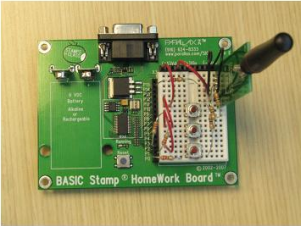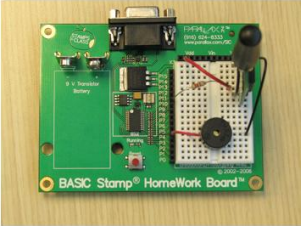Run the Code
Figures 6 & 7 - Circuit wiring for the transmitter (left) and receiver (right) boards


Wiring for the two boards should look something like the above figures.
MultiButtonTx.bs2
- Enter and run MultiButtonTx.bs2 into your transmitter board.
- Disconnect your programming cable from your tilt controller, but leave the battery (or DC supply) connected so the program keeps running.
- Move on to MultiButtonRx.bs2
' {$STAMP BS2}
' {$PBASIC 2.5}
' MultiButtonTx.bs2
' Transmit pushbutton states for multiple pushbuttons using the 433 MHz
' RF Transceiver.
TxPin PIN 14
TR PIN 15
Baud CON 16468
PbStates VAR Byte
HIGH TR ' T/R Line High - Transmit
DO
PbStates = INA ' Input Pins P3..P0
SEROUT TxPin, Baud, [PbStates] ' Transmit all push button states
PAUSE 10
LOOP
MultiButtonRx.bs2
- Enter and run MultiButtonRx.bs2 in your receiver board.
- Verify that when you push each of the pushbuttons on your transmitter board, a tone plays on your receiver board.
- If necessary, troubleshoot the circuit connections and/or code.
- Once each button plays a different note, you can play the first seven notes of “Twinkle, Twinkle Little Star” by pressing the first pushbutton twice, the second twice, the third twice, and the second once.
' {$STAMP BS2}
' {$PBASIC 2.5}
' MultiButtonRx.bs2
' Receive pushbutton states using the 433 MHz RF Transceiver and play
' tones based on what's received.
RxPin PIN 10
TR PIN 11
Baud CON 16468
PbStates VAR Byte
LOW TR ' T/R Line low - receive
DO
SERIN RxPin, Baud, [PbStates] ' Read all Pushbutton states
SELECT PbStates ' Select all Pushbutton states
CASE %0001 ' Pushbutton at P0 is pressed
GOSUB Play_C ' Execute subroutine Play_C
CASE %0010 ' Pushbutton at P1 is pressed
GOSUB Play_G ' Execute subroutine Play_G
CASE %0100 ' Pushbutton at P2 is pressed
GOSUB Play_A ' Execute subroutine Play_A
ENDSELECT
LOOP
Play_C:
FREQOUT 4, 500, 2093
RETURN
Play_G:
FREQOUT 4, 500, 3136
RETURN
Play_A:
FREQOUT 4, 500, 3520
RETURN
How it Works
MultiButtonTx.bs2
The program MultiButtonTx.bs2 utilizes the SEROUT command to transmit the states of the pushbuttons to the receiver board. The INA argument is what’s called the “Nibble Name” which monitors the states of all devices connected to pins 0-3. Recall that the command DEBUG ? IN3 prints “IN3 = 1” or “IN3 = 0” in the Debug Terminal depending on whether the pushbutton is pressed. So when the command INA is called, it’s really the same as calling IN0, IN1, IN2, IN3. Then, when SEROUT TxPin, Baud, [PbStates] is called; it then sends the state of each pushbutton connected to P0, P1, P2, and P3 to the Parallax 433 MHz RF Transceiver.
MultiButtonRx.bs2
The program MultiButtonRx.bs2 utilizes the SEROUT command to receive the states of the pushbuttons from the transmitter board. However, it’s also a bit more complicated, since once the states are received, the program then has to decide what to do. In order to sort each pushbutton state, the program uses a SELECT…CASE command. Once SELECT PbStates is called, the received values of each pushbutton state are loaded into RAM as a byte. However, there are four states that are received.
So how does the BASIC Stamp 2 store these values? The simplest way to analyze how this is done is to read each byte in binary. Since PbStates was defined as a Byte, there are four “spots” for the state of each pushbutton. Remember, binary only stores values as 0’s or 1’s, and 0 is usually denoted as low and 1 as high. So if we assign each “spot” to one pushbutton, the CASE command can be used to execute subroutines based on PbStates’s binary value. The table below shows examples of how the BASIC Stamp will read each pushbutton state based on the binary value it has received. Our program is checking the states of the first three pushbuttons, but the INA command can check the first three pins, if desired.
|
Binary Value |
Pushbutton Reaction |
|
%0000 |
No PB Pressed |
|
%0001 |
PB connected to P0 pressed |
|
%0010 |
PB connected to P1 pressed |
|
%0100 |
PB connected to P2 pressed |
|
%0011 |
PB connected to P0 & P1 pressed |
|
%0111 |
PB connected to P0, P1 & P2 pressed |
Therefore, by knowing the binary equivalent of each pushbutton being pressed; the CASE command can be used to compare each binary condition to PbStates and execute a subroutine based on that value. In this program, depending on which pushbutton is pressed, a different note will play.
